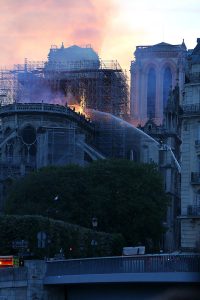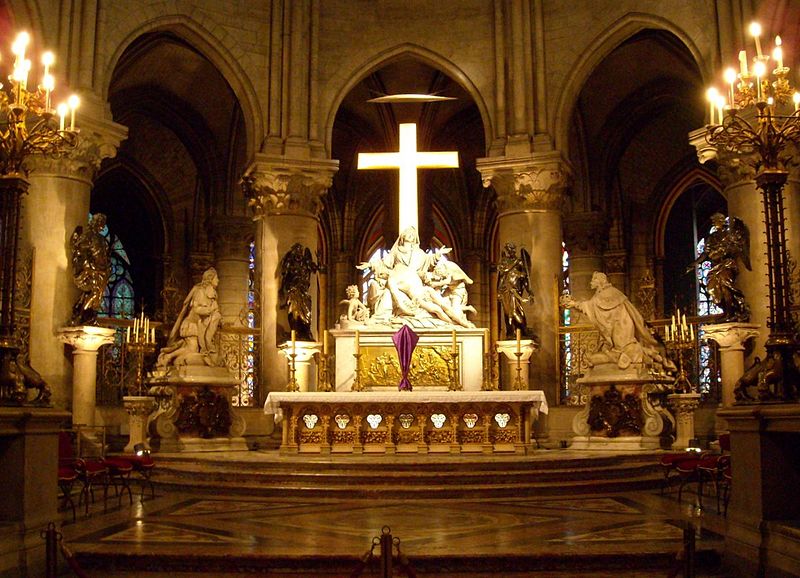Many have commented on the fact that Paris’s Notre Dame Cathedral burned during Holy Week (see here or here or here for just a few examples), and rightfully so — the symbolism of death and the hope of resurrection is hard to miss. Particularly striking were the images of the cathedral’s golden cross still standing amid the wreckage. It being Holy Week, my first thoughts were three traditional invocations of the Cross of Christ.
First was the motto of the Carthusians, Stat Crux dum volvitur orbis: “The Cross stands firm while the world turns.” As one would expect from the motto of an order of contemplative hermits, the maxim calls attention to the primordial importance of spiritual realities. The world turns, empires rise and fall, the sun shines and rain falls on the bad and the good, our own lives come into being and pass away — but the Cross stands firm. It alone gives meaning to what we do and it alone shows us where to direct our gaze. It is of course important to do our part in “turning the world” — we are both soul and body, after all, and what happens in the material world is not irrelevant to what happens in the spiritual world. But we should keep in mind that only one will last.
O Crux ave, spes unica: “Hail, O Cross, our only hope,” begins a stanza of Vexilla Regis, an ancient Passiontide hymn. Similar to the image of the Cross standing still in a turning world, the cross is our only hope in that, without the salvation that God has given through it, we are left in a meaningless rut without an end to look to. The Cross is not the final end, of course — Easter Sunday thankfully comes after Good Friday — but it is an essential part of the way of Holy Week, and the way of salvation history. In this vein it is crucial to bear in mind the spiritual end of man, not reducing him to numbers, consumption, whims, pleasures, or anything else. The Cross shows us God but it also shows us man, in all his fullness — a fullness that is essential for flourishing in both a spiritual and material sense.
 Another phrase that the images of Notre Dame called to mind is Crux fidelis, inter omnes arbor una nobilis: “Faithful Cross, the one noble tree among all,” which comes from a stanza of Venantius Fortunatus’s 6th-century Good Friday hymn. The emphasis here on the Cross as a “tree” reminds us of the sacramentality of nature, of how God can take material creations and transform them for his own ends. During Holy Week two striking examples of this are the bread and wine of the Eucharist on Holy Thursday and the wood of the Cross on Good Friday. The “sacraments” are called such precisely because they are visible manifestations of invisible realities. But “sacramentality” also applies more generally, in reference to man’s place as steward of Creation. In our use of God’s gifts to serve others and fulfill our own needs, we fulfill not only our call but the “sacramental” vocation of Creation itself. Adam was commanded to till the garden; the new Adam “tilled” it in the most perfect way possible through his salvation on the tree of the Cross.
Another phrase that the images of Notre Dame called to mind is Crux fidelis, inter omnes arbor una nobilis: “Faithful Cross, the one noble tree among all,” which comes from a stanza of Venantius Fortunatus’s 6th-century Good Friday hymn. The emphasis here on the Cross as a “tree” reminds us of the sacramentality of nature, of how God can take material creations and transform them for his own ends. During Holy Week two striking examples of this are the bread and wine of the Eucharist on Holy Thursday and the wood of the Cross on Good Friday. The “sacraments” are called such precisely because they are visible manifestations of invisible realities. But “sacramentality” also applies more generally, in reference to man’s place as steward of Creation. In our use of God’s gifts to serve others and fulfill our own needs, we fulfill not only our call but the “sacramental” vocation of Creation itself. Adam was commanded to till the garden; the new Adam “tilled” it in the most perfect way possible through his salvation on the tree of the Cross.
Much can be drawn from these hymns to the Cross, but their fundamental message remains the same — without the sacrifice and Resurrection of Christ, all else loses its meaning. This is precisely what Holy Week is meant to recall to us. On the sixth day of Creation God made man, the pinnacle of his works. On the new sixth day of the Cross, he gave us the still more magnificent work of redemption. The cross left standing amid the ruins of Notre Dame calls us back to the fundamental importance of that work.
(Photo credits: Benchaum, Wikimedia Commons, CC BY-SA 3.0; Cangadoba, Wikimedia Commons, CC BY-SA 4.0)

